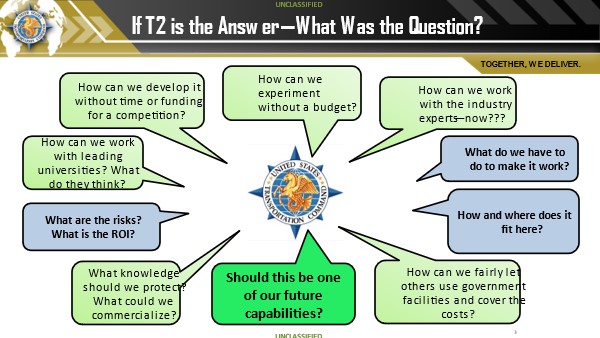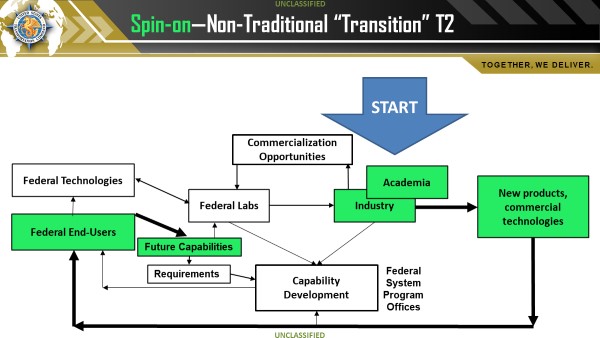The principal mechanism of T2-based collaboration in USTRANSCOM is the Cooperative Research and Development Agreement (CRADA), governed by Title 15 United States Code, Section 3710a.
T2 agreements, including CRADAs, are voluntary for both the federal and non-federal entity (the latter is known as the "Collaborator"). While the government may seek one or more Collaborators, a Collaborator may initiate the dialogue with the government seeking a CRADA; neither party is compelled to enter or remain in a T2 agreement.
Elements of the CRADA Joint Work Plan

CRADAs in USTRANSCOM are utilized to explore and mature concepts, techniques, and technologies to allow the government to better understand the feasibility and risks of these capabilities for the future. CRADAs are not substitutes or precursors for acquisition or procurement. Instead, CRADAs are methods of experimentation, in a Public-Private Partnership mode, influenced by or conducted in the DOD environment, to better understand future operating concepts and their enabling technologies, techniques and business cases, and to better understand the implications and risks of emerging technologies as well as procedures which are new to the DOD.
Inventions or innovations jointly produced by the collaboration are jointly owned by both USTRANSCOM and the Collaborator as described in the intellectual property provisions of the specific T2 agreement.
CRADAs are not considered “acquisition” and not subject to the Federal Acquisition Regulations (FAR). These agreements cannot result in payment of Federal funds to the Collaborator. USTRANSCOM may provide personnel, services, facilities, equipment, intellectual property, or other resources. The non-Federal parties may provide funds, personnel, services, facilities, equipment, intellectual property, or other resources toward the conduct of specified research or development efforts that are consistent with the mission of USTRANSCOM. Any property and equipment provided under technology transfer mechanisms will be provided in accordance with established property management policies and procedures. The government typically provides access to information systems, data, physical infrastructure, test agencies, and subject matter expertise, as documented in the terms of the CRADA's Joint Work Plan, as its contribution to the partnership. The Collaborator gains from exposure and exercise of proprietary material and concepts in the demanding DOD environment, which encourages maturation of the technology or technique.
CRADAs are typically 1-2 years in duration, with well-defined and limited research objectives. Constraining CRADAs in this manner assists both the Collaborator and the government to plan for and commit the right resources to the mutual development work. USTRANSCOM and the Collaborators appoint their own "Principal Investigators" (i.e., project managers) to lead the experimental efforts and exercise the collaboration.
A typical outcome of a CRADA is a report on the results of the experimentation, a prototypical application of the technology, and enhanced government ability to articulate the boundaries of its future capabilities. Intellectual property produced is identified, inventoried, and archived with agreement on government and Collaborator use rights. The Collaborator gains a more mature product or technique and an understanding of the potential future customer of the capability. CRADAs provide protection of intellectual property (IP) to the Collaborator and government. CRADA information is protected from disclosure under the Freedom of Information Act (FOIA) for up to five years.












